remove seats HONDA FIT 2016 3.G Quick Guide
[x] Cancel search | Manufacturer: HONDA, Model Year: 2016, Model line: FIT, Model: HONDA FIT 2016 3.GPages: 75, PDF Size: 5.39 MB
Page 7 of 75
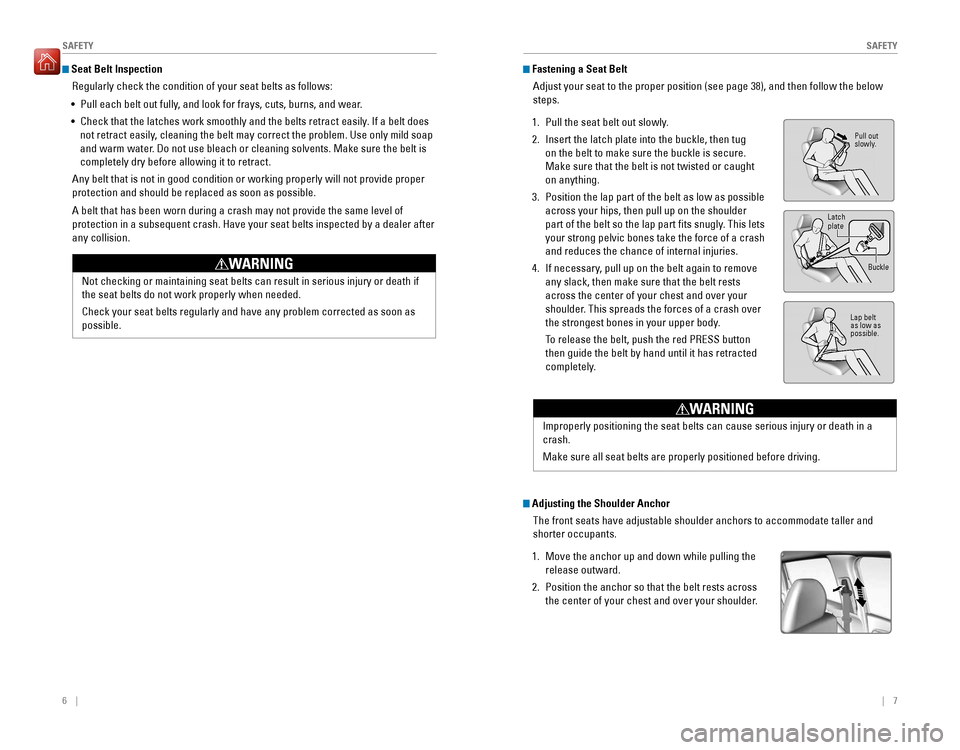
6 || 7
S
AFETY
SAFETY
Seat Belt Inspection
Regularly check the condition of your seat belts as follows:
• Pull each belt out fully, and look for frays, cuts, burns, and wear.
• Check that the latches work smoothly and the belts retract easily. If a belt does not retract easily, cleaning the belt may correct the problem. Use only mild soap
and warm water. Do not use bleach or cleaning solvents. Make sure the belt is completely dry before allowing it to retract.
Any belt that is not in good condition or working properly will not provide proper protection and should be replaced as soon as possible. A belt that has been worn during a crash may not provide the same level of protection in a subsequent crash. Have your seat belts inspected by a dealer after any collision.
Not checking or maintaining seat belts can result in serious injury or death if the seat belts do not work properly when needed. Check your seat belts regularly and have any problem corrected as soon as possible.
WARNING
Fastening a Seat Belt
Adjust your seat to the proper position (see page 38), and then follow the below steps.
1. Pull the seat belt out slowly.
2. Insert the latch plate into the buckle, then tug on the belt to make sure the buckle is secure. Make sure that the belt is not twisted or caught on anything.
3. Position the lap part of the belt as low as possible across your hips, then pull up on the shoulder
part of the belt so the lap part its snugly. This lets
your strong pelvic bones take the force of a crash and reduces the chance of internal injuries.
4. If necessary, pull up on the belt again to remove any slack, then make sure that the belt rests across the center of your chest and over your
shoulder. This spreads the forces of a crash over
the strongest bones in your upper body.
To release the belt, push the red PRESS button then guide the belt by hand until it has retracted
completely.
Adjusting the Shoulder Anchor
The front seats have adjustable shoulder anchors to accommodate taller and shorter occupants.
1. Move the anchor up and down while pulling the release outward.
2. Position the anchor so that the belt rests across
the center of your chest and over your shoulder.
Improperly positioning the seat belts can cause serious injury or death in a crash. Make sure all seat belts are properly positioned before driving.
WARNING
Pull out
slowly.
Lap belt as low as possible.
Latch plate
Buckle
Page 13 of 75
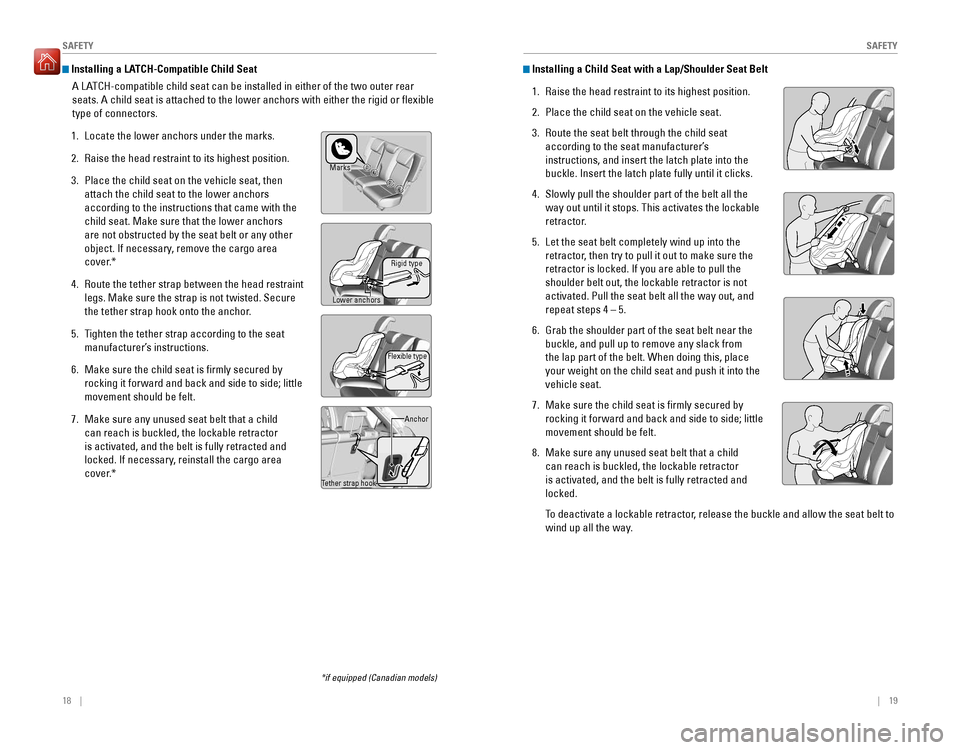
18 || 19
S
AFETY
SAFETY
Installing a LATCH-Compatible Child Seat
A LATCH-compatible child seat can be installed in either of the two outer rear
seats. A child seat is attached to the lower anchors with either the rigid or lexible type of connectors.
1. Locate the lower anchors under the marks.
2. Raise the head restraint to its highest position.
3. Place the child seat on the vehicle seat, then attach the child seat to the lower anchors according to the instructions that came with the child seat. Make sure that the lower anchors are not obstructed by the seat belt or any other
object. If necessary, remove the cargo area
cover.*
4. Route the tether strap between the head restraint legs. Make sure the strap is not twisted. Secure
the tether strap hook onto the anchor.
5. Tighten the tether strap according to the seat manufacturer’s instructions.
6. Make sure the child seat is irmly secured by rocking it forward and back and side to side; little movement should be felt.
7. Make sure any unused seat belt that a child
can reach is buckled, the lockable retractor is activated, and the belt is fully retracted and
locked. If necessary, reinstall the cargo area
cover.*
Installing a Child Seat with a Lap/Shoulder Seat Belt
1. Raise the head restraint to its highest position.
2. Place the child seat on the vehicle seat.3. Route the seat belt through the child seat
according to the seat manufacturer’s instructions, and insert the latch plate into the buckle. Insert the latch plate fully until it clicks.
4. Slowly pull the shoulder part of the belt all the way out until it stops. This activates the lockable
retractor.
5. Let the seat belt completely wind up into the
retractor, then try to pull it out to make sure the retractor is locked. If you are able to pull the shoulder belt out, the lockable retractor is not activated. Pull the seat belt all the way out, and repeat steps 4 – 5.
6. Grab the shoulder part of the seat belt near the buckle, and pull up to remove any slack from the lap part of the belt. When doing this, place your weight on the child seat and push it into the vehicle seat.
7. Make sure the child seat is irmly secured by rocking it forward and back and side to side; little movement should be felt.
8. Make sure any unused seat belt that a child
can reach is buckled, the lockable retractor is activated, and the belt is fully retracted and locked.
To deactivate a lockable retractor, release the buckle and allow the seat belt to wind up all the way.
Marks
*if equipped (Canadian models)
Rigid type
Lower anchors
Flexible type
Anchor
Tether strap hook
Page 23 of 75
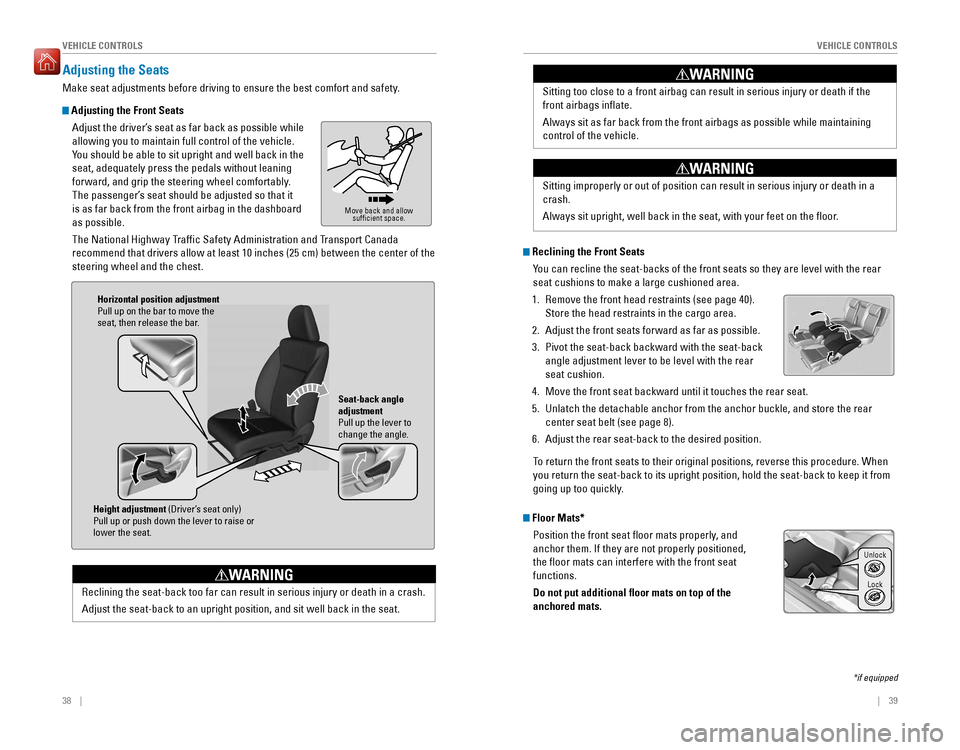
38 || 39
V
EHICLE CONTROLS
VEHICLE CONTROLS
Reclining the seat-back too far can result in serious injury or death in a crash. Adjust the seat-back to an upright position, and sit well back in the seat.
WARNING
Adjusting the Seats
Make seat adjustments before driving to ensure the best comfort and safety.
Adjusting the Front Seats
Adjust the driver’s seat as far back as possible while allowing you to maintain full control of the vehicle.
You should be able to sit upright and well back in the seat, adequately press the pedals without leaning
forward, and grip the steering wheel comfortably.
The passenger’s seat should be adjusted so that it is as far back from the front airbag in the dashboard as possible.
The National Highway Traf�c Safety Administration and Transport Canada
recommend that drivers allow at least 10 inches (25 cm) between the center of the steering wheel and the chest.
Move back and allow
suf�cient space.
Height adjustment (Driver’s seat only)
Pull up or push down the lever to raise or lower the seat. Seat-back angle adjustment
Pull up the lever to change the angle.
Horizontal position adjustment
Pull up on the bar to move the
seat, then release the bar. Sitting improperly or out of position can result in serious injury or death in a crash.
Always sit upright, well back in the seat, with your feet on the loor.
WARNING
Floor Mats*
Position the front seat �oor mats properly, and
anchor them. If they are not properly positioned, the �oor mats can interfere with the front seat functions. Do not put additional �oor mats on top of the anchored mats.
Unlock
Lock
Sitting too close to a front airbag can result in serious injury or death if the front airbags inlate. Always sit as far back from the front airbags as possible while maintaining control of the vehicle.
WARNING
Reclining the Front Seats
You can recline the seat-backs of the front seats so they are level with the rear seat cushions to make a large cushioned area.
1. Remove the front head restraints (see page 40). Store the head restraints in the cargo area.
2. Adjust the front seats forward as far as possible.
3. Pivot the seat-back backward with the seat-back angle adjustment lever to be level with the rear seat cushion.
4. Move the front seat backward until it touches the rear seat.
5. Unlatch the detachable anchor from the anchor buckle, and store the rear center seat belt (see page 8).
6. Adjust the rear seat-back to the desired position.
To return the front seats to their original positions, reverse this procedure. When you return the seat-back to its upright position, hold the seat-back to keep it from
going up too quickly.
*if equipped
Page 24 of 75
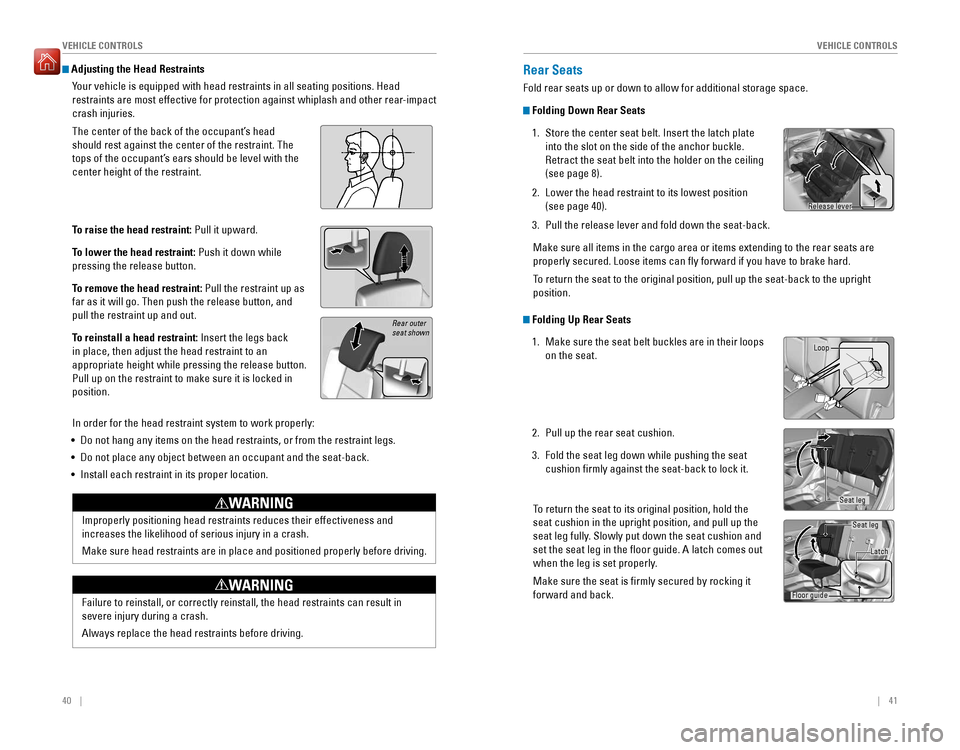
40 || 41
V
EHICLE CONTROLS
VEHICLE CONTROLS
Improperly positioning head restraints reduces their effectiveness and increases the likelihood of serious injury in a crash.
Make sure head restraints are in place and positioned properly before driving.
WARNING
Failure to reinstall, or correctly reinstall, the head restraints can result in severe injury during a crash. Always replace the head restraints before driving.
WARNING
Adjusting the Head Restraints
Your vehicle is equipped with head restraints in all seating positions. Head
restraints are most effective for protection against whiplash and other rear-impact crash injuries.
The center of the back of the occupant’s head should rest against the center of the restraint. The
tops of the occupant’s ears should be level with the center height of the restraint.
To raise the head restraint: Pull it upward.
To lower the head restraint: Push it down while
pressing the release button.
To remove the head restraint: Pull the restraint up as
far as it will go. Then push the release button, and pull the restraint up and out.
To reinstall a head restraint: Insert the legs back
in place, then adjust the head restraint to an appropriate height while pressing the release button. Pull up on the restraint to make sure it is locked in position. In order for the head restraint system to work properly:
• Do not hang any items on the head restraints, or from the restraint legs.
• Do not place any object between an occupant and the seat-back.
• Install each restraint in its proper location.
Rear outer seat shown
Rear Seats
Fold rear seats up or down to allow for additional storage space.
Folding Down Rear Seats
1. Store the center seat belt. Insert the latch plate into the slot on the side of the anchor buckle. Retract the seat belt into the holder on the ceiling (see page 8).
2. Lower the head restraint to its lowest position (see page 40).
3. Pull the release lever and fold down the seat-back.
Make sure all items in the cargo area or items extending to the rear seats are properly secured. Loose items can ly forward if you have to brake hard.
To return the seat to the original position, pull up the seat-back to the upright position.
Folding Up Rear Seats
1. Make sure the seat belt buckles are in their loops on the seat.
2. Pull up the rear seat cushion.
3. Fold the seat leg down while pushing the seat cushion irmly against the seat-back to lock it.
To return the seat to its original position, hold the seat cushion in the upright position, and pull up the
seat leg fully. Slowly put down the seat cushion and set the seat leg in the �oor guide. A latch comes out
when the leg is set properly. Make sure the seat is irmly secured by rocking it forward and back.
Release lever
Loop
Seat leg
Seat leg Latch
Floor guide
Page 45 of 75
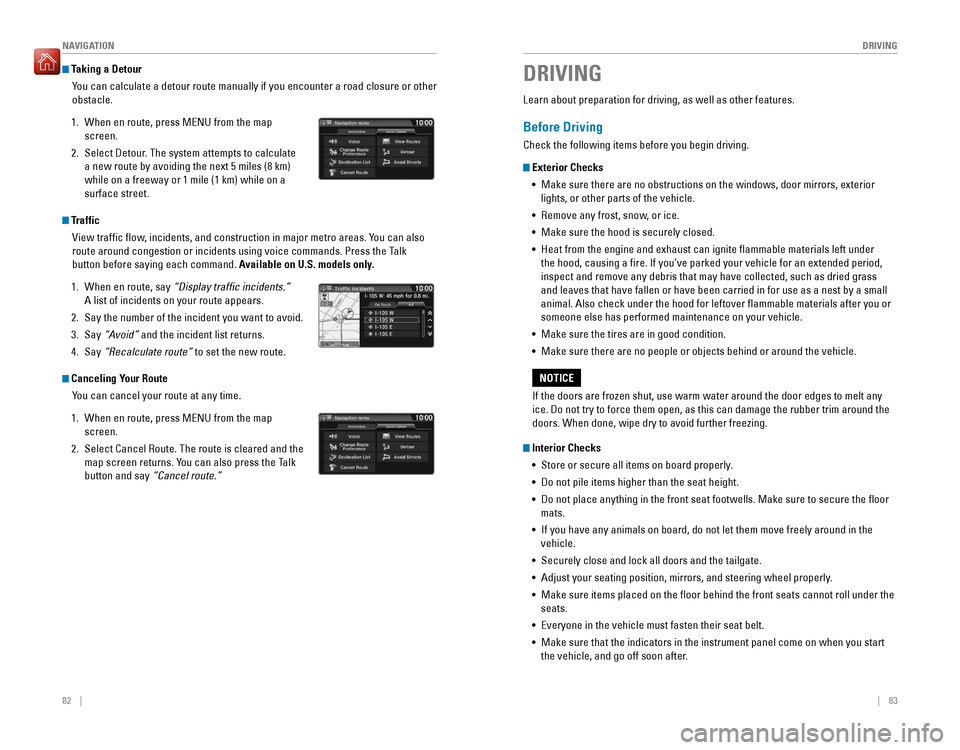
82 || 83
DRIVING
NAVIGATION
Taking a Detour
You can calculate a detour route manually if you encounter a road closure or other obstacle.
1. When en route, press MENU from the map screen.
2. Select Detour. The system attempts to calculate a new route by avoiding the next 5 miles (8 km) while on a freeway or 1 mile (1 km) while on a surface street.
Traffic
View traf�c �ow, incidents, and construction in major metro areas. You can also
route around congestion or incidents using voice commands. Press the Talk
button before saying each command. Available on U.S. models only.
1. When en route, say “Display trafic incidents.”
A list of incidents on your route appears.
2. Say the number of the incident you want to avoid.
3. Say “Avoid” and the incident list returns.
4. Say “Recalculate route” to set the new route.
Canceling Your Route
You can cancel your route at any time.
1. When en route, press MENU from the map screen.
2. Select Cancel Route. The route is cleared and the map screen returns. You can also press the Talk button and say “Cancel route.”
Learn about preparation for driving, as well as other features.
Before Driving
Check the following items before you begin driving.
Exterior Checks
•
Make sure there are no obstructions on the windows, door mirrors, exterior
lights, or other parts of the vehicle.
• Remove any frost, snow, or ice.
• Make sure the hood is securely closed.
• Heat from the engine and exhaust can ignite lammable materials left under
the hood, causing a ire. If you’ve parked your vehicle for an extended period,
inspect and remove any debris that may have collected, such as dried grass and leaves that have fallen or have been carried in for use as a nest by a small animal. Also check under the hood for leftover lammable materials after you or someone else has performed maintenance on your vehicle.
• Make sure the tires are in good condition.
• Make sure there are no people or objects behind or around the vehicle.
Interior Checks
• Store or secure all items on board properly.
• Do not pile items higher than the seat height.
• Do not place anything in the front seat footwells. Make sure to secure the loor mats.
• If you have any animals on board, do not let them move freely around in the
vehicle.
• Securely close and lock all doors and the tailgate.
• Adjust your seating position, mirrors, and steering wheel properly.
• Make sure items placed on the loor behind the front seats cannot roll under the
seats.
• Everyone in the vehicle must fasten their seat belt.
• Make sure that the indicators in the instrument panel come on when you start
the vehicle, and go off soon after.
DRIVING
If the doors are frozen shut, use warm water around the door edges to melt any ice. Do not try to force them open, as this can damage the rubber trim around the doors. When done, wipe dry to avoid further freezing.
NOTICE